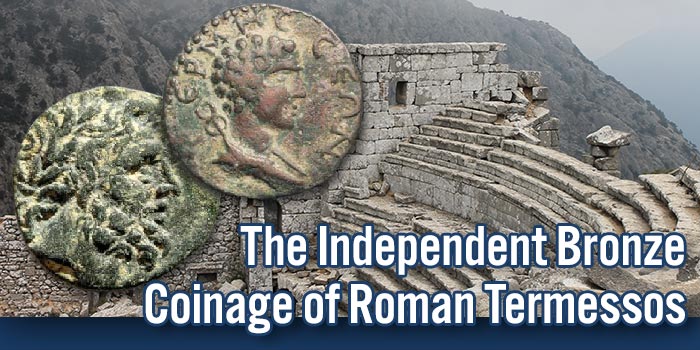
By Tyler Rossi for CoinWeek …..
High in the mountains of Pisidia in Anatolia, near the Mediterranean coast of what is now southwestern Turkey), lay the remarkably well-preserved ruins of Termessos Major. Unconquered by man, the city was felled by nature when an earthquake destroyed a local aqueduct in the fifth century CE (AD).
Despite the city’s location within Roman territory, Termessos formed an ill-fated alliance against Rome during the final Mithridatic war. Following the conclusion of hostilities, however, Rome magnanimously reinstated Termessos’ tax-exempt status and local control. This “independent status”, which guaranteed all civil freedoms and rights, was jealously guarded and highly lauded by the local citizens, called Solymi, to such an extent that they enshrined it on their coinage.
During its autonomous period throughout the late Roman Republic, the city of Termessos minted a series of AE bronze coinage commemorating its symbolic separation from Rome. As is common on Greek coinage, the obverse side depicts a right-facing head of Zeus. The Roman influence peeks through on the series’ reverse which depicts a left-facing galloping horse, a “clumsy copy” of a quadriga–or four-horse chariot–frequently found on Roman denarii. Under the horse is the legend TEP, for Termessos and above the horse sits a Greek letter signifying the year in which each coin was produced, with “A” representing the city’s first year of renewed autonomy, “B” representing the second year, and so on. Thus, each coin demarcates a period in time between the years 72/1-41/0 BCE when a micro-state continued to exist deep within Roman-held lands even after that state actively fought against Roman interests.

The visual design and numbering system are not the only historically significant aspects of the Termessos coinage, however.
Given that the city was located inside “Rome”, the existence of the coins themselves serves as evidence of the “complex and multilayered identities” that Rome fostered within its territory. In fact, one reason Rome survived for over a thousand years was its adaptability and willingness to integrate new ideas, technology, and cultural identities (including non-Roman coinage) into existing state mechanisms.
Gradually, as Rome transformed into an empire, the Solymi coinage morphed into a more standardized Roman style, as exemplified by the AE 26 coin below. Nevertheless, it still retained a certain provincial otherness.

Although examples of this coinage series are rather common and generally inexpensive (a fine example can be acquired for under $75 USD), the simplicity of design belies its historical importance. In fact, if a numismatist is interested in acquiring an example, it is not unusual for examples to come up for sale in online auctions or at a local coin show with a dealer of ancient coins.
* * *
Sources
www.wildwinds.com/coins/greece/pisidia/termessos_major/
French, David, and Alan Stirling Hall. Studies in the History and Topography of Lycia and Pisidia: in Memoriam A.S. Hall. British Inst. of Archaeology at Ankara, c/o British Acad., 1994
turkisharchaeonews.net/site/termessos
https://www.academia.edu/4125316/Pseudo-mints_again_a_die-study
https://globalheritagefund.org/2016/08/01/imagining-ancient-history-in-the-ruins-of-termessos/
* * *
About the Author
Tyler Rossi is currently a graduate student at Brandeis University’s Heller School of Social Policy and Management and studies Sustainable International Development and Conflict Resolution. Before graduating from American University in Washington D.C., he worked for Save the Children creating and running international development projects. Recently, Tyler returned to the US from living abroad in the Republic of North Macedonia, where he served as a Peace Corps volunteer for three years. Tyler is an avid numismatist and for over a decade has cultivated a deep interest in pre-modern and ancient coinage from around the world. He is a member of the American Numismatic Association (ANA).





Great article!! Especially looove the ae26. Hermes…Athena!! Nike! Id love to be able to find one for $75!!